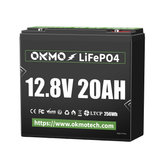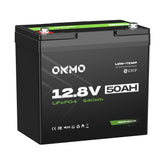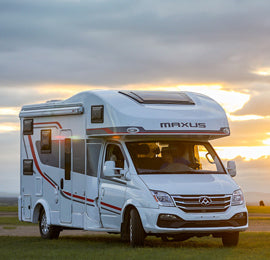How Often to Replace a Car Battery?
 — An In-Depth Analysis of Replacement Cycles for RV Energy Storage Lithium Batteries to Ensure Uninterrupted Outdoor Living
— An In-Depth Analysis of Replacement Cycles for RV Energy Storage Lithium Batteries to Ensure Uninterrupted Outdoor Living
When most people think of "replacing a car battery," they refer to traditional lead-acid starter batteries designed for engine ignition, which typically need replacement every 3-5 years. However, for RV, camper, and houseboat owners, we are discussing an entirely different category—the world of deep-cycle batteries, with the modern preferred choice being Lithium Iron Phosphate (LiFePO4) batteries.
This article will provide an in-depth exploration of how often the LiFePO4 battery, serving as the core of RV energy storage, should be replaced to ensure the continuous and stable operation of equipment such as lighting, refrigerators, and air conditioning systems.
I. Core Concept: A Paradigm Shift from "Time" to "Cycles"
Unlike traditional starter batteries, which are judged based on their "service life in years," the key metric for assessing the lifespan of deep-cycle batteries is "cycle life."
-
Starter Batteries: Deliver instantaneous high current to start the engine and are promptly recharged afterward. Their degradation stems primarily from long-term float charging, natural aging, and minor discharge cycles.
-
Deep-Cycle Batteries: Designed for consistent, stable, and deep discharging, followed by a full recharge—a process termed one "cycle." Their lifespan is directly determined by the number of cycles they undergo and the depth of each discharge.
Therefore, asking "How many years will a LiFePO4 battery last?" is an imprecise question. The correct question is: "How many charge-discharge cycles can it endure given my usage patterns?"
 II. Why LiFePO4 is a Revolutionary Choice for RV Energy Storage?
II. Why LiFePO4 is a Revolutionary Choice for RV Energy Storage?
Compared to traditional deep-cycle lead-acid batteries (like AGM or Gel batteries), LiFePO4 batteries offer overwhelming advantages in lifespan, performance, and safety:
-
Exceptional Cycle Life: This is the most critical difference. A high-quality LiFePO4 battery typically boasts a cycle life of 3,000 to 5,000 cycles or even more (at 80% Depth of Discharge). In contrast, top-tier AGM lead-acid batteries usually offer only 500-1000 cycles.
-
Higher Depth of Discharge (DoD): You can safely discharge a LiFePO4 battery to 80%-90% of its capacity without causing significant damage. Regularly discharging lead-acid batteries beyond 50% DoD drastically shortens their lifespan.
-
Lighter Weight and Higher Energy Density: For the same capacity, lithium batteries weigh only one-third to one-half as much as their lead-acid counterparts.
-
More Stable Chemistry: The LiFePO4 chemistry offers high thermal stability and safety, making it less prone to fire or explosion.
III. Practical Calculation of LiFePO4 Battery Replacement Intervals
Let's calculate a realistic replacement timeline using a specific scenario:
Assumptions:
-
You own a 100Ah LiFePO4 battery.
-
The battery specifications state: 4,000 cycles at 80% Depth of Discharge.
-
Your average daily power consumption in the RV is 50Ah (equivalent to 50% of the battery's total capacity).
Calculation Process:
-
Cycle Definition: While you aren't fully draining and recharging the battery from 100% to 0%, each charge-discharge event counts as a "cycle." Using 50% of the capacity daily equates to 0.5 standard cycles per day.
-
Total Service Life (in days):
-
Total Cycles / Daily Cycles = Total Battery Usage Days
-
4,000 cycles / 0.5 cycles/day = 8,000 days
-
-
Conversion to Years:
-
8,000 days / 365 days/year ≈ 21.9 years
-
 Conclusion: Under this idealized usage scenario, your battery could theoretically operate reliably for nearly 22 years before needing replacement.
Conclusion: Under this idealized usage scenario, your battery could theoretically operate reliably for nearly 22 years before needing replacement.
Analysis of Real-World Variables:
However, real-world conditions are more complex. The actual replacement interval is influenced by these factors:
-
Actual Depth of Discharge: If you are a "weekend warrior" using only 20% of the capacity per trip, the battery's lifespan will be even longer. Conversely, if you are a full-time RVer consuming 80% daily, the lifespan will be proportionally shorter.
-
Charging Practices: Consistently charging to 100% and maintaining a full charge (especially in high-temperature environments) can induce stress. Optimal practice involves charging to 90%-95% and avoiding prolonged storage at full charge when possible.
-
Temperature Environment: High temperatures are the "number one killer" of lithium batteries. Continuous use and charging in hot environments significantly accelerate battery degradation. High-quality battery packs often include heating and cooling systems to mitigate this issue.
-
Battery Quality: Inexpensive LiFePO4 batteries using low-quality cells, lacking a Battery Management System (BMS), or having a poor BMS may have a much shorter actual lifespan than advertised.
 IV. When Should You Consider Replacing Your RV Lithium Battery?
IV. When Should You Consider Replacing Your RV Lithium Battery?
Even with a theoretically long lifespan, you should monitor the actual health of your battery. The following signs are warning indicators that replacement might be needed:
-
Significant Capacity Reduction: This is the most direct indicator. If you notice that a full charge now lasts less than a day whereas it previously lasted two days, it signifies a substantial decrease in usable capacity. Typically, when capacity degrades to 80% of its initial rating, it is considered the end of the battery's useful life.
-
Abnormal Charge/Discharge Rates: The battery seems to "charge fully instantly and drain immediately," or charging times become abnormally long.
-
BMS Alarms: Modern LiFePO4 batteries are equipped with a BMS. Frequent alarms reporting voltage, temperature, or current irregularities warrant attention.
-
Physical Changes: Although rare, if the battery shows signs of bulging, deformation, or leakage, you must stop using it immediately and replace it.
 V. Conclusion and Final Recommendations
V. Conclusion and Final Recommendations
For RV and camping enthusiasts, upgrading from lead-acid to LiFePO4 batteries is a highly valuable investment. Regarding the replacement cycle, we can draw the following core conclusions:
-
Farewell to "Replace Every Three Years": The lifespan concept of LiFePO4 batteries is fundamentally different from that of traditional starter or lead-acid deep-cycle batteries.
-
Cycles are King, a Decade is Achievable: Under typical usage patterns (e.g., weekly use, seasonal long trips), a high-quality LiFePO4 battery system can reliably be expected to provide over 10 years of service. For less frequent users, the lifespan may even exceed 15 years.
-
Investing in Quality is Key: Purchasing batteries from reputable brands, featuring robust BMS and substantial warranties (many premium brands offer 10-year warranties), is fundamental to achieving the theoretical lifespan.
 Ultimately, there's no need to worry constantly about "how often to replace it." By choosing a high-quality LiFePO4 battery and using and maintaining it correctly, it will become a silent yet powerful companion ensuring over a decade of carefree outdoor living.
Ultimately, there's no need to worry constantly about "how often to replace it." By choosing a high-quality LiFePO4 battery and using and maintaining it correctly, it will become a silent yet powerful companion ensuring over a decade of carefree outdoor living.








